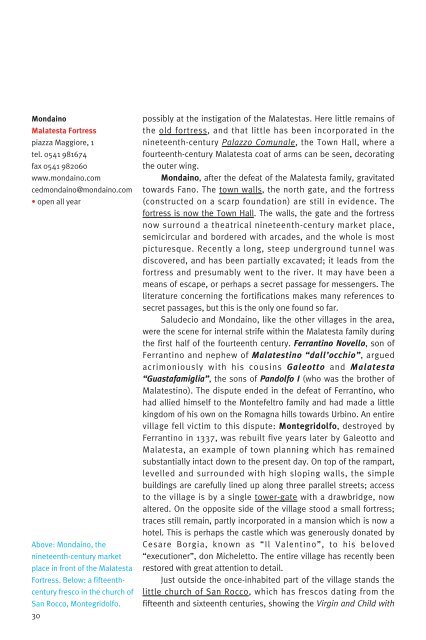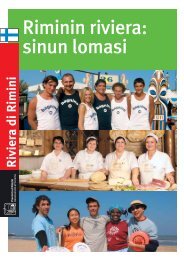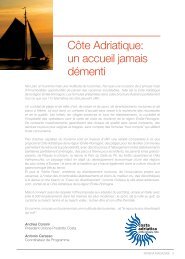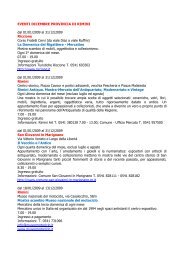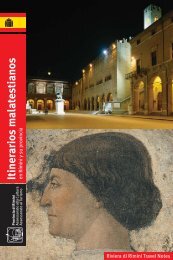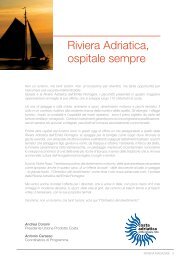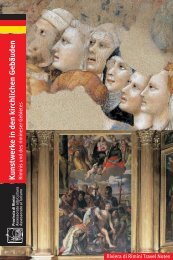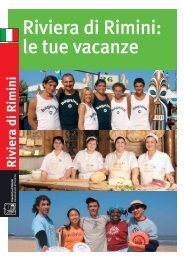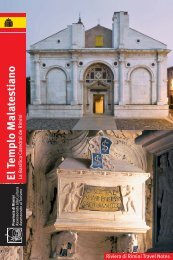Malatesta fortresses and castles
Malatesta fortresses and castles
Malatesta fortresses and castles
- No tags were found...
Create successful ePaper yourself
Turn your PDF publications into a flip-book with our unique Google optimized e-Paper software.
Mondaino<strong>Malatesta</strong> Fortresspiazza Maggiore, 1tel. 0541 981674fax 0541 982060www.mondaino.comcedmondaino@mondaino.com• open all yearAbove: Mondaino, thenineteenth-century marketplace in front of the <strong>Malatesta</strong>Fortress. Below: a fifteenthcenturyfresco in the church ofSan Rocco, Montegridolfo.30possibly at the instigation of the <strong>Malatesta</strong>s. Here little remains ofthe old fortress, <strong>and</strong> that little has been incorporated in thenineteenth-century Palazzo Comunale, the Town Hall, where afourteenth-century <strong>Malatesta</strong> coat of arms can be seen, decoratingthe outer wing.Mondaino, after the defeat of the <strong>Malatesta</strong> family, gravitatedtowards Fano. The town walls, the north gate, <strong>and</strong> the fortress(constructed on a scarp foundation) are still in evidence. Thefortress is now the Town Hall. The walls, the gate <strong>and</strong> the fortressnow surround a theatrical nineteenth-century market place,semicircular <strong>and</strong> bordered with arcades, <strong>and</strong> the whole is mostpicturesque. Recently a long, steep underground tunnel wasdiscovered, <strong>and</strong> has been partially excavated; it leads from thefortress <strong>and</strong> presumably went to the river. It may have been ameans of escape, or perhaps a secret passage for messengers. Theliterature concerning the fortifications makes many references tosecret passages, but this is the only one found so far.Saludecio <strong>and</strong> Mondaino, like the other villages in the area,were the scene for internal strife within the <strong>Malatesta</strong> family duringthe first half of the fourteenth century. Ferrantino Novello, son ofFerrantino <strong>and</strong> nephew of Malatestino “dall’occhio”, arguedacrimoniously with his cousins Galeotto <strong>and</strong> <strong>Malatesta</strong>“Guastafamiglia”, the sons of P<strong>and</strong>olfo I (who was the brother ofMalatestino). The dispute ended in the defeat of Ferrantino, whohad allied himself to the Montefeltro family <strong>and</strong> had made a littlekingdom of his own on the Romagna hills towards Urbino. An entirevillage fell victim to this dispute: Montegridolfo, destroyed byFerrantino in 1337, was rebuilt five years later by Galeotto <strong>and</strong><strong>Malatesta</strong>, an example of town planning which has remainedsubstantially intact down to the present day. On top of the rampart,levelled <strong>and</strong> surrounded with high sloping walls, the simplebuildings are carefully lined up along three parallel streets; accessto the village is by a single tower-gate with a drawbridge, nowaltered. On the opposite side of the village stood a small fortress;traces still remain, partly incorporated in a mansion which is now ahotel. This is perhaps the castle which was generously donated byCesare Borgia, known as “Il Valentino”, to his beloved“executioner”, don Micheletto. The entire village has recently beenrestored with great attention to detail.Just outside the once-inhabited part of the village st<strong>and</strong>s thelittle church of San Rocco, which has frescos dating from thefifteenth <strong>and</strong> sixteenth centuries, showing the Virgin <strong>and</strong> Child with


